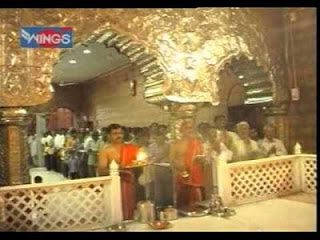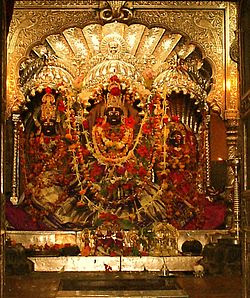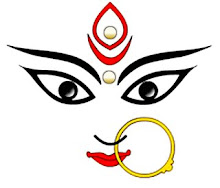 |
| Shirdi Sai Baba |
Shirdi was a
very small and insignificant village in Maharashtra, quite unknown to most
people. It is in the district of Ahmednagar. One has to cross the Godavari
river at a place called Kopergaon before reaching Shirdi. For some inexplicable
reason known only to himself, this was the place chosen by the great saint,
Shirdi Sai Baba to make His appearance. Today it has become a flourishing town
attracting millions of devotees from all over the world because it was on this
blessed spot that Sai Baba played his immortal “lilas”.
Myself and my
husband have been wanting to go to Shirdi for many years and for some reason or
the other, the visit could not materialize.
All of a sudden, to our astonishment, everything started to fall in its
place and finally this month[April-2013], we could feel the call of Sri Shirdi
Sai and knew that the time had come for us to be there to have His darshan!
It is said
that no one can go to Shirdi without Baba’s permission so I prayed to him to
grant my request. Hardly a week later a series of episodes took place which can
only be termed as a “miracle”. A set of
people whom I had never met arranged the whole trip for us. The person who
arranged the trip – is one Mr. Lokesh- an ardent Sai devotee. He has been organizing tours for the past
seven years now. We came to know of this
only a week back through a friend of ours and ever since that magical moment,
everything started falling in place very rightly and at a quick pace. We were quite overwhelmed as can be imagined
but decided to play along with Baba’s lilas. The travel arrangements were done
to perfection by Mr. Lokesh-[the Tour
conductor] and in no time our trip was finalized and we were on our
way. We were more than twenty persons
going on this trip and for many – it was the first time to Shirdi temple to
have that magical feeling of exhilaration on seeing Sai Baba!
I
was very excited. … I was going to
Shirdi and going to see Baba at the Samadhi Mandir. That’s all I had in my mind.
Our visit to Shirdi was an exciting and spiritual
experience, the memory of which will last a lifetime. From the moment we got down at Daund Station[
the station before Pune], and took a the Luxury Coach which was hired for us by
our friend and Guide-Mr. Lokesh, we were all consumed with anticipation and the
feeling of exhilaration that one would very soon set foot on the sacred soil of
Shirdi….and would be enveloped and awed by the aura of the great Guru God who
charmed and ennobled the lives of thousands of devotees far and near for more
than a decade and continues to do so even after his death 95 years ago[
1838-1918].
To one who was familiar with Sai Baba’s life and the
times in which he lived, Kopergaon was an important name with which was
associated many incidents connected with Sai Baba and his devotees. If one remembers Sai Baba, one has to
remember Kopergaon too, for it was there that the devotees came first on their
way to Shirdi. It is said that this
place has been the scene of some of Baba’s miracles.
 |
| The Old Shirdi Village |
The Old village of Shirdi with about 100 mud houses is
gone and what is there of Shirdi is the vast temple complex ringed by hundreds
of big and small shops and big and small hotels. All that one could identify with the old
Shirdi, I am told are three or four houses where some of Baba’s intimate
devotees lived. Those are the houses of
Mahlsapathy, Baba’s oldest devotee, Lakshmi Bai and Shama [will narrate on our visit to these houses later in the posting of
mine.
We left by
Chennai Express on the 3rd of April morning. Our train journey was very comfortable and we
enjoyed every moment of it. Lokesh- our
Guide had clearly given us instructions that we were to board off the train at
Daund Station [ the station before Pune] as he said that it would be easier and
quicker from there to reach Shirdi.
After the long
journey from Chennai, we all were a bit relieved to be off the train and had a
few minutes to stretch our legs and relax.
Once all of us had gathered, we were taken to our Luxury Traveling Coach
which our Guide had hired for the next two days to take us to Shirdi temple and
the temples nearby. Our accommodation
was also arranged at a very good hotel [Annaporna
Hotel] in Shirdi- very close to the temple.
The food served by them was excellent and tasted like “Amrit” after having darshan of
Baba!
I should
mention here that Sai Baba is vibrant, alive and responsive wherever we are and
myself and my husband could feel it as soon as we landed in Shirdi..
On reaching
Shirdi in the late afternoon at around 4pm, we quickly refreshed ourselves and Lokesh-our ever-cheerful friend and Guide-
took us for the first Darshan of Baba.
As every one
of us know, of late - Shirdi has become very crowded beyond imagination. After
waiting for more than two to three hours in the queue for Samadhi Mandir Darshan, it is really sad to say that you are pushed
and hassled by the Security persons, who are invariably rude- - similar to the Sri
Balaji Darshan in Thirupathi. This
aspect could be avoided, as Sai Baba looked upon all his devotees with love and
affection and I feel I should mention here one of His eleven assurances to all
his devotees, which is:
[quote]
” Show unto me
he who has sought refuge and has been turned away”
[un-quote].
Being Thursday
[ the auspicious day for Sai Baba] and in spite of our long wait in the queue,
our first darshan of Baba left us speechless with joy. He looked so beautiful.
The statue is made of white marble and looks quite life like. He was seated in
His classic pose on a granite stone with his right leg bent over the left and
left hand resting on his right foot. It felt as though he was looking straight
at us and smiling. The magnificent attire in Blue, worn by Baba, was
spell-bounding!
 |
| Sai Baba |
It looked as
though HE had been waiting for us to come all these years. My eyes filled with
tears and I just could not contain my emotions. I knew then that it was indeed
true that he was still there calling his devotees to him, blessing them with
the fulfilment of their desires, blessing them with enlightenment if that was
what they desired. I should say that this feeling of being with Baba was simply
marvellous and over-whelming!
 |
| The Original Samadhi Temple |
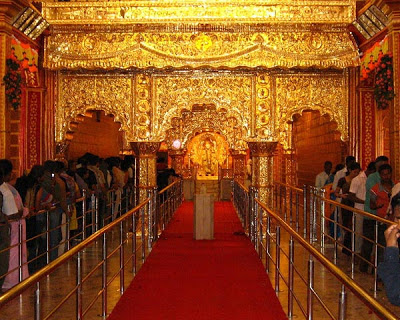 |
| The Renovated Splendid Samadhi Temple |
The most important building in the complex is the Sai
Baba Samadhi Mandir. We were told that
it was built by a Nagpur millionaire, a devotee of Baba, Bapusaheb Buti, and
was called Buti Wada. Sai Baba’s body
was interred in the site reserved by Buti to build a Krishna temple and Baba’s
Samadhi has come up here. The Samadhi
has been built with white marble stone.
Around the Samadhi railing, one can see ornamental decoratin. In front are two Padukas of Baba and the brick which was
broken ad led to Baba predicting his death, is kept near the Samadhi. Just behind the Samadhi is Baba’s statue made
of Italian marble. It shows him seated
on a throne which thousands of his devotees all over the country know and
worship. Overhanging the statue is a
silver umbrella and the back of the statue is made of silver and with swastik
signs depicted on the sides. Above the
statue on the wall is engraved this couplet:
“ Raghupati Raghava
Rajaram
Patita Pawan Sainam
“
One cannot miss reading the inscription on the high
ceiling behind the statue:
“Sachidananda
Sat Guru Sai Maharaj Ki Jai”
 |
| Inside of the Samadhi Mandir |
 |
| View of the Samadhi of Sri Sai Baba |
 |
| Samadhi Mandir |
It is in this big hall facing the Samadhi that thousands
of devotees take part in the daily arati performed four times a day. It is really delightful, even for the Gods,
to hear when prayers go to Baba in a uniform crescendo, from thousand
throats. One can feel the atmosphere
being surcharged with emotion and ecstacy!
Then you can find in the Samadhi Mandir in a separate
enclosure are kept in view articles used by Baba and the various items of
paraphernalia which formed part of the durbar held by Baba who was treated and
feted as a maharaja like the royal umbrella, silver mace, whisks and othe
symbols of royalty.
Another thing was the dogs. You could find dogs roaming
inside the temple, they were well fed, clean and very social too.
We made it a
point to go the very next day too and have darshan of Baba to our hearts’
content. We could not resist the urge to
be with Him and seek His Blessings. The
one and a half days we were in Shirdi was a truly wonderful experience.
 |
| Dwarakamai-1905 |
 |
| Original Dwarakamai |
 |
| Devotees seated in Dwarakamai |
 |
Dilapidated Shirdi Masjid [also known as the
Brahmin Mosque] |
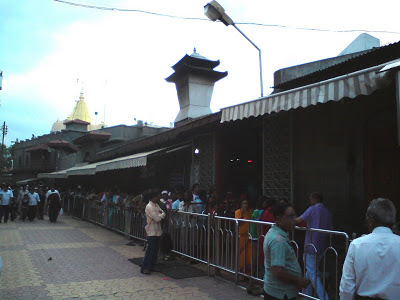 |
Renovated Dwarakamai-Long Queue
for Darshan |
Not far from the mandir is Dwaraka Mai or the masjid
where Baba stayed all his life after he came to Shirdi. It was then said to be a dilapidated mosque
which was not used by muslims and it was in such an awful condition that parts
of it were crumbling all the time.
Baba’s devotees offered to build for him another residence but he would
not agree to move from the place nor would he agree until the very last moment
to repairs being made to make it habitable.
But today, one can see this place renovated and does not look like a
mosque at all. It is a very small place hardly 30 ft by 15 ft and one
wonders how Baba would have lived there with so many devotees and visitors
occupying the limited space. Baba called
it Dwaraka Mayi [ he also called it once “ A Brahmin Mosque” to respect Hindu
sentiment.
 |
| Sai Baba sitting near "Dhuni" |
As one enters Dwaraka Mai, one notices on the left the “
dhuni “ which Baba created from the moment he settled in the mosque and which
still burns as it did throughout his lifetime.
It was by the side of the dhuni that Baba sat ad received devotees and
visitors and to mark the spot- a portrait of Baba has been installed on the
side of the wall. In the front are two
pillars where Baba used to stand in the evenings and greet passersby and talk
to them. In the corner on the right is a
large stone on which Baba sat while taking a bath. Further inside on the right at the extreme
corner is the grinding stone which Baba used for grinding wheat into flour and
by its side is kept a closed rack with stored wheat. On the opposite side, on the left, is
preserved the mud pot in which Baba kept the alms he got daily and placed it
outside the mosque to enable crows, dogs and beggars to share the food with
them. A big open hut has been put up in
front of Dwaraka Mayi to serve as a prayer hall and place of meditation. Here opposite to Dwaraka Mai, there is
another picture of Baba and below it is the famous stone on which Baba sat in
contemplation. The picture of Baba in
this posture is the one seen in the homes of thousands of devotees.
 |
| Original Chavadi |
.png) |
| Renovated Chavadi of today |
A short distance from Dwaraka Mai is the Chavadi, another landmark of Shirdi. Baba slept in the chavadi on alternate nights. He is taken in procession there and there is
always an elaborate ceremony before Baba retires for the night. The Chavadi has also been renovated and it
looks neat and clean. It is a very small
building, with a partition which served as Baba’s bedroom. In the bedroom, there is a picture of Baba
and a notice which warns women from entering it. In the hall on one side, there is a cot on
which Baba’s body was placed for a sacred bath after his passing away. On the other side is a chair mounted with
sheels, An inscription says that it has been there since Baba’s time but it is
not known if Baba every used it. The
Chavadi we were told, was the village
guest house and it is said that Baba had taken part in entertainments there in
the early years of his arrival to Shirdi and he had been seen singing and
dancing.
 |
| Gurusthan Mandir |
Sai Baba first came to Shirdi in the form of Bal Yogi - a child ascetic. He was first spotted seated under a neem tree. THis place came to be known as Gurusthan. The Gurusthan was renovated on 30th September, 1941. After this the present temple was built. There is a small shrine in Gurusthan. On an elevated platform of this shrine a big portrait of Lord Sai Baba is placed. On the side is a marble statue of Baba. In front of the portrait is a Shiva lingam and the Nandi. Photos of twelve Jyotirlingas are also kept in the temple. Here burning of incense is done to get rid of problems in once life.
Another landmark which our Guide pointed out, is the Neem
Tree, which has been preserved. It was
under this tree which Baba sat when he first came to Shirdi in the latter half
of the 19th century, some say, as a young boy of 16. A mantap has been built round the tree and it
is called Gurusthan. To protect the tree
from the bark being peeled off by devotees., a trunk has been covered by a
shield. There is always a long queue of
devotees during pradakshina of the tree and its sacredness is exemplified in
this prayer”
 |
| The Sacred Neem Tree |
…..I
bow down to the Lord Sad Guru Sainath who by his constant abode at the foot of
the margosa tree, whose juice though by nature is bitter and distasteful has
turned it nectar-like-sweet because he has exalted the tree above the legendary
Kalpavrish[wish-fulfilling tree]”. The
reference to the juice of the Neem tree in the prayer is attested by devotees
who say that some of the leaves of the tree taste bitter which is its natural
quality while some others taste sweet
which is unnatural…..
It is also said and believed that there are 5 lamps still
burning under the tree in which Baba came to rest – the Gurusthan.
Truly amazing experience!
We also went to the Donation
office to pay a small donation towards “AnnaDhaan”. We did not miss out on the Book-stall though
and made it a point to buy the Sai Charithra”.
I should
mention here that Baba’s presence was always with us – in every move and every
thought ! A fantastic experience and
very, very blissful indeed.
We again had a
quick “Mukh Darshan of Sai Baba from
outside. Though reluctant to leave, since time was running out on us as we had to
cover many other famous pilgrim spots in and around Shirdi, associated with
Baba we made our exit from the Shirdi Temple, carrying with us fond memories of
having been with Baba and for having given us a good darshan..
 |
| Lendi Garden |
At some distance from the Gurusthan is Lendi, the garden
which Baba laid with his own hands, digging and plating trees and watering
them.
 |
| Khandoba Temple |
 |
| God Khandoba |
On the other side of the national highway to Agra is the
Khandoba Temple where Baba was refused shelter by Mahlsapathy, its priest, on
the grounds that he was a muslim. It was
then that Baba decided to make the dilapidated mosque his home. It is said that Mahlsapathy later realised
his mistake and became an ardent devotee of Baba. When Baba left his body for a short while, in
the early years if his stay in Shirdi, it was to Mahlsapathy that he entrusted
ot. Mahlsapathy guarded the body and
refused to surrender it for burial in spite of pressure from the officials and
the local people. Baba came back to life
after three days. Khandoba temple is
very small and Khandoba himself, engraved in granite stone, looks like a
way-side god we see in the country side.
Other notable things which are not to be missed in the
temple complex are the samadhis of Shyamkarna, the horse which was in the
vanguard of the procession to the chavadi and back and for the unknown and
unidentified tiger which, brought before Baba by its keeper to cure it from its
sickness, breathed its last at his feet.
Tiny memorials have been erected over these samadhis enclosed with a
small horse and tiger statuettes.
The
daily rituals at the Sai Samadhi Mandir consists of four Aratis [worship],
namely:
Every Thursday night before the arati, Baba is
symbolically taken in a procession from Dwaraka Mayi to the Chavadi where he
used to sleep every alternate night. His
padukas and portrait are placed in a palanquin after worship and the procession
wends its way to the chavadi which Is quiet nearby. The procession has all the marks of royalty
and other aspects associated with it. At
the chavadi, there is an elaborate ceremony before Baba is symbolically put to
bed. He is fed and his clay pipe put to
His mouth for him to have a puff or two, everything symbolically of course.
Sanstan officials
told us that there were three official festivals every year and they are:
- Sri Rama Navami
- Guru Poorima and
- Dasara or Punya Tithi.
 |
| Rama Navami Festival |
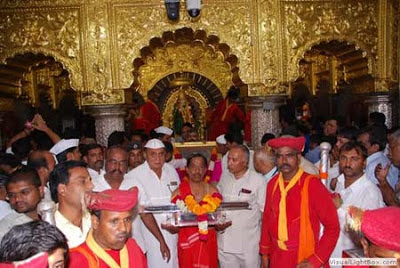 |
| GuruPoornima |
Each of these festivals is celebrated for three days with
cultural and religious functions.
An interesting fact about our visit to Shirdi is that the
devotee has not to pay anything at any time.
Darshan of Baba is free and so are visits to Dwaraka Mayi and chavadi
and other important places associated with Baba. Hundi boxes called Dashina Bo sae kept in the
Sai Samadhi Mandrir where devotees can make their contributions as part of
their homage to Baba but there is no compulsion. Close circuit TV sets outside the mandir and
at Dwaraka Mayi enable the devotees to watch the arati ceremony. We were told that at the conclusion of the
morning arati, Vishnu Sahasranama, a favourite of Baba, recorded by Srimathi
M.S. Subbalakshmi on a cassette is broadcast.
Nearby, is the house of Mahlsapathy who passed away four
years after the Samadhi of Baba. Now his
grand-daughter lives in the house sanctified by Mahlsapathy who was the first
to fall Baba “Sai Baba”—which has now become a mantra in millions of homes
throughout the country. We were indeed
very fortunate to have seen his grand-daughter there during our visit and were
very happy to have exchanged a few plasanteries with her.
 |
| The House of Mahlsathy |
It is here that Baba’s Padukas presented to Mahlsapathy
by Baba were shown to all the visitors.
These padukas are lent to various Sai shrines in different parts of the
country for devotees to pay homage.
I had been
repeatedly asking the people who were escorting me, whether there was anyone
left in Shirdi who had seen Baba but they said that they had never met anyone. I
had the feeling of joy when we realized that Baba had led us to the person very
close to him – Mahalsapati’s
grand-duaghter--Baba’s
grace is really inexplicable.
We could not believe our luck as we were very
fortunate to have exchanged a few words with her and also bought some
articles/soveneirs sold there in fond memory of Sai Baba. This was a great feeling indeed.
 |
| The House of Laxmi Bai Shinde |
Not far away is Lakshmi Bai’s house. Lakshmi Bai was a ardent devotee of Baba and
she was one of the priviledged persons before whose house Baba stopped and
asked for alms.
We came to know from our
Guide and also the Sansthan officials that a few days before Baba passed away,
Baba called her and gave her nine coins to preserve and worship. These coins are imbedded in the heart of a
statue of Lakshmi Bai kept in the centre of the house.
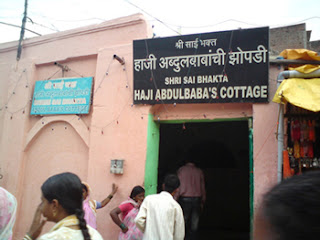 |
| Abdul Baba's Cottage |
Other landmarks in the temple complex which remind one of
the times of Baba are the samadhis of Tatya Patil, a favourite child and
devotee of Baba, whose mother Bayyaji Bai used to chase Baba in the forest and
hills to feed him and who Baba claimed was his sister in a previous birth, and
that of Abdul the personal attendant of Baba who served Baba faithfully till
the last and became a yogi himself, ministering to the needs of Baba’s
devotees.
As far as I could gather, I feel too much emphasis is
laid on ritual worship of Baba and too little on the moral and spiritual values
inculcated by Baba. One finds everywhere inside the temple, notices warning the
devotees to protect themselves against being pick-pocketed or robbed. It saddens me to think that with such
anti-social elements could dare enter the sacred portals of the living God,
shows to reveal that much work remains to be done to develop character and
moral values which are so dear to Baba’s heart.
Ritual worship and spreading the message of good character, love and
compassion must go hand in hand and we would be nearer to achieving the task
set before his devotees by the immortal Sai Baba.
 |
| Sai Darshan |
We could gather from the Sansthan officials that an
average of 15 to 20 thousand pilgrims visit Shirdi daily and it touches an
amazing figure of 1 lakh on Sundays and holidays!
I should say
that the bliss of getting the darshan of Sai Baba is so soothing and unique in
its own way and I wish everyone should have the feel at least
once in their life time.
As we came to end of the pilgrim spots, we
could snatch some precious time for some shopping. We managed to buy a few articles associated
with Baba’s life in Shidi as soveneirs and also for distribution to our friends
and relatives out there in Chennai.
It was already nearing noon as we were
getting ready to pack-off from Shirdi.
We had a long journey planned on the way back. Lokesh- our friend and GuidE, had arranged
for darshan of some good temples in Nasik – namely the Triambakeshwar Temple [one of the 12 Jyotir Lingams],
Panchavati. We had also been to Shani Shingnapur,
before reaching Shirdi – presiding deity being Shani Bhagwan and had good
darshan.
My Posting on Shirdi visit is quite
a long one and hence I shall explain in detail of our experiences on these
above mentioned additional temples which we visited en-route from Shirdi in my
next Posting.
Our dear Friend and Guide- Mr. Lokesh [ also known as
Loganathan], made each and every moment of our trip enjoyable and a
memorable one. I should mention here
that he is definitely one of the most accommodative persons I have ever
met. If not for him, I am sure our trip
to Shirdi would not have materialized!! He is available on +91- 80157 58577.
 |
| Oh Supreme Sai.... |
Our
Shirdi visit was indeed a very pleasant one
and very, very dear to us.
I wish to say……
“Oh Supreme SAI. I cannot thank You enough. I can only pray to You to
keep me and every one under Your wings always, and accept us as Your children. …”
We prayed for all the fellow devotees, who
long to have a Darshan of Baba, should have a BLISSFUL one. May BABA shower His
blessing always on every devotee.
At the end of it all, I
must say that me and my husband and the rest of us in troupe, felt fortunate
enough to have visited Shirdi.
I would say -------“It was Gods’ will”. JAI SAI RAM.














.png)







